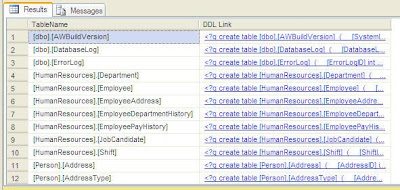use AdventureWorksThis produces the output below in the Grid Results window. Clicking on any of the hyperlinks will bring up the code for that object in a new window.
go
select ObjType=type_desc
,ObjName=schema_name(schema_id)+'.'+name
,ObjDefLink
from sys.objects
cross apply (select ObjDef=object_definition(object_id)) F1
cross apply (select ObjDefLink=(select [processing-instruction(q)]=ObjDef
for xml path(''),type)) F2
where type in ('P' /* Procedures */
,'V' /* Views */
,'TR' /* Triggers */
,'FN','IF','TF' /* Functions */
)
and ObjDef like '%ContactTypeID%' /* String to search for */
order by charindex('F',type) desc /* Group the functions together */
,ObjType
,ObjName

Piotr Rodak (who has a very nice blog, and he also has, by far, the most clever blog name in existence) left a comment on my last post saying, “It’s a pity that table definitions cannot be acquired in a similar way.”
Wow, what a great idea! Imagine yourself walking into a new client (or new job) with a database with hundreds of tables and no documentation anywhere. Yes, you could right-click on the database in Object Explorer and choose Tasks -> Generate Scripts… from the popup menu and go through all the dialogs, and then generate a single code window or a single file or (if you have SQL2008) separate files for each object.
But instead, how about a query that produces a list of tables in the database, along with a hyperlink to the DDL Code for the table (and all its indexes)?
Coo-ul.
I was up for the challenge, and so I put a (looonngg) query together to do just that. Using the Object Catalog Views (i.e. sys.tables, sys.columns, etc), it generates the vast majority of the DDL Code for a table… the only features it leaves out are anything that has to do with Data Compression, Sparse Columns, Column Sets, FileStream, and Partitioning. Some things I left out because of time… other things I left out because they were SQL2008-only features and I wanted the query to work in both SQL2005 and SQL2008.
Here is the output of the query for the AdventureWorks database:

And, if we click on the hyperlink for the HumanResources.EmployeeDepartmentHistory table, for example, we get the following (in an XML window):

And to get the syntax coloring in a new code window, we perform a couple of keystrokes: CTRL+A (Select All), CTRL+C (Copy), CTRL+F4 (Close Window), CTRL+N (New Query Window), CTRL+V (Paste), and then a few DELETE keystrokes to get rid of the XML delimiters at the beginning and the end, and there’s the code for the creation of the table. Note the columns, their defaults, the check constraints, primary key constraint, foreign key references, and the (non-primary-key) index definitions for the table.

The code for this query is too long to incorporate here in this blog article, but you can download it from my SkyDrive. It’s just a single query, so you can easily incorporate it into a stored procedure if you wish.
Thanks again to Piotr for his comment that acted as the catalyst for this idea. I hope you find it to be helpful.





Wow,
ReplyDeleteThanks for posting this, I am going to play with it now.
That is the coolest thing! Thank you for posting it!
ReplyDeleteWow Brad, this is very flattering, I really enjoy the role of catalyst :)
ReplyDeleteThis is really cool script!
Now we need to catalyze someone - maybe Mladen - who will hook up your script to a context menu in SSMS :)
Brad,
ReplyDeleteit needs a small change.
For nchar and nvarchar datatypes length should be divided by 2.
The rest looks cool. Thank you.
Aaaaacckk! Thanks for catching that, Leonid. It's been fixed and an updated version is at the SkyDrive.
ReplyDeleteThanks for all the comments, everyone... I'm glad you liked the script!
ReplyDeleteHey Brad, how about adding in permissions?
ReplyDeleteCROSS APPLY
(/* Get Permissions for Table */
SELECT
STUFF
((SELECT
char(13) + char(10)
+ [perms].[state_desc]
+ ' '
+ [perms].[permission_name]
+ ' ON '
+ QUOTENAME(OBJECT_SCHEMA_NAME([perms].[major_id]))
+ '.'
+ QUOTENAME(OBJECT_NAME([perms].[major_id]))
+ ' TO '
+ QUOTENAME([prin].[name])
FROM
sys.database_permissions AS [perms]
JOIN
sys.database_principals AS [prin]
ON [perms].[grantee_principal_id] = [prin].[principal_id]
WHERE
[t].[object_id] = [perms].[major_id]
FOR XML PATH(''), TYPE).value('.', 'nvarchar(max)')
, 1, 2, '')
) AS [Permissions]([PermissionList])
cross apply ( /* Set up the DDL Link */
select [DDL Link]=(select [processing-instruction(q)]=
'create table '+TableName
+char(13)+char(10)+'('
+char(13)+char(10)+' '+ColumnList
+coalesce(char(13)+char(10)+' /* Check Constraints */'
+char(13)+char(10)+ChkConstList,'')
+coalesce(char(13)+char(10)+' /* Primary Key */'
+char(13)+char(10)+IxConstList,'')
+coalesce(char(13)+char(10)+' /* Foreign Keys */'
+char(13)+char(10)+FKConstList,'')
+char(13)+char(10)+')'
+coalesce(char(13)+char(10)+'/* Non-Primary-Key Indexes */'
+char(13)+char(10)+IndexList,'')
+COALESCE(char(13)+char(10)+'/* Permissions */'
+char(13)+char(10)+[PermissionList], '')
+char(13)+char(10)
for xml path(''),type)) F_Link
Check http://www.mindsdoor.net/DMO/DMOScriptAllDatabases.html
ReplyDelete
ReplyDeleteVery Helpful Article. เล่นบาคาร่า 2020 It might help you. เล่นบาคาร่า 2020 Thanks For Sharing
เล่นบาคาร่า 2020 Thank you very much.
ReplyDeleteThis Is Really Useful And Nice Information. เล่นบาคาร่า 2020
This are such great articles. เล่นบาคาร่า 2020 This articles can help you to make some new ideas.
เล่นบาคาร่า 2020 I appreciate for reading my blogs.
I am very glad to see this post. This is very helpful for developers. I appreciate your great technique to use in this article. Thanks for sharing all the explanations well. Keep sharing more solutions from this article. Now it's time to get chauffeur service birmingham for more information.
ReplyDelete>The code for this query is too long to incorporate here in this blog article, but you can download it from my SkyDrive
ReplyDeleteFor some reason that link seems not to be working for me... Is there any chance you could add the code into the article, or to upload it to GitHub or some similar service?
Thanks in advance.